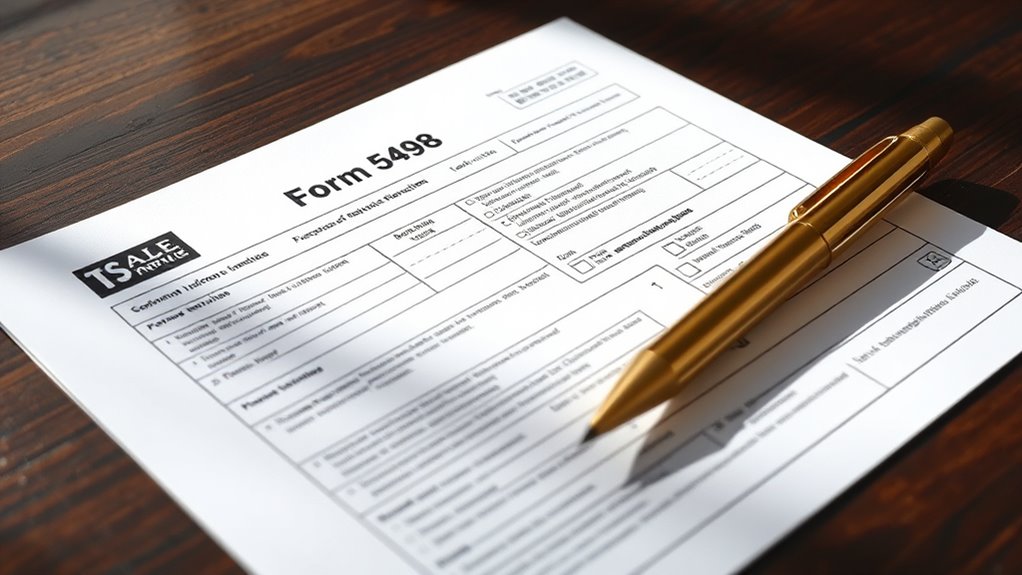To correctly report your Gold IRA contributions on Form 5498, you need to guarantee that your custodian includes the contribution amount and asset details, such as precious metals or real estate, using specific asset codes in boxes 15a and 15b. The form shows your contribution limits, rollovers, and fair market value, helping verify your activity for IRS compliance. Understanding these details helps you avoid errors or audits—continue exploring for detailed guidance.

Ever wonder how the IRS keeps track of your IRA contributions and transactions? It all comes down to Form 5498, a essential document filed annually by your IRA custodian or trustee. This form reports your contributions, rollovers, conversions, and the fair market value (FMV) of your account as of December 31 of the previous year. While you don’t file it with your tax return, reviewing it carefully is necessary to make sure everything lines up correctly. The IRS uses this data to verify your reported activity, prevent underreporting, and catch potential errors, making your awareness of this form important for accurate tax compliance. Understanding the form’s purpose helps ensure that your contributions are correctly recorded and that you remain compliant with IRS regulations.
On the form, you’ll find detailed information about your traditional and Roth IRA contributions, including any carryback contributions. If you’ve rolled over funds from another IRA or converted a Roth IRA, those transactions are also recorded here. For employer-sponsored plans like SEP and SIMPLE IRAs, your contributions are documented as well. Additionally, the form reports the FMV, providing a snapshot of your account’s value as of December 31, which is essential for calculating required minimum distributions or verifying account worth during audits. If you’ve recharacterized contributions or made qualified repayments, such as disaster-related withdrawals, these are noted too, helping you keep your records straight.
Custodians are responsible for filing Form 5498 with the IRS and mailing copies to IRA owners by May 31 each year. This deadline guarantees they include contributions made during the tax extension period from January to April, giving you time to finalize your tax filings. Having this information early allows you to verify that your reported contributions match what you’ve recorded, helping you avoid discrepancies that could trigger IRS inquiries or audits.
For those holding alternative assets like gold, precious metals, real estate, or LLC interests in their IRAs, the form includes specific codes in boxes 15a and 15b. These codes indicate asset types that lack a public market or readily available FMV, ensuring transparency and helping the IRS monitor potential prohibited transactions. When you contribute physical gold or other precious metals to your IRA, your custodian reports these contributions, including their FMV, to demonstrate compliance with IRS rules for alternative assets. This reporting helps identify taxable events like distributions or sales through related forms such as 1099-B.
Frequently Asked Questions
Can I Amend Incorrect Contributions Reported on Form 5498?
You can’t directly amend incorrect contributions reported on Form 5498. However, if you discover an error, you should contact your IRA trustee or administrator promptly to request a corrected form. Make sure to provide proof of your intended contribution date. Acting quickly helps avoid penalties, and if corrections aren’t possible, you might need to file an amended tax return to fix the mistake.
How Does Form 5498 Interact With IRS Audits?
Think of Form 5498 as a roadmap for your IRA, guiding the IRS through your contributions and distributions. When you verify this form is accurate, it acts like a shield, helping you avoid unnecessary audits. Mistakes can trigger red flags, so double-check your data. Properly reporting rollovers, contributions, and RMDs keeps your financial journey smooth and reduces the risk of IRS scrutiny.
Are There Penalties for Late Reporting on Form 5498?
You’re probably wondering if there are penalties for late reporting on Form 5498. While the IRS emphasizes timely filing to maintain compliance, penalties mainly target trustees or issuers who fail to file on time. If you’re responsible for submitting the form, late filings can result in fines ranging from $60 to over $600 per return, especially if delays are significant or intentional. To avoid these penalties, file promptly or request an extension if needed.
Does Form 5498 Include Rollover Contributions?
Yes, your Form 5498 includes rollover contributions. When you transfer funds from another retirement account into your IRA, the trustee reports this in Box 2. This includes direct rollovers from traditional, Roth, or other IRAs, as well as rollovers from qualified plans like 401(k)s. Precise reporting guarantees the IRS tracks your rollover transactions properly, helping you avoid possible penalties or tax issues later on.
How Do I Interpret the Fair Market Value Listed on Form 5498?
Imagine the FMV as a mirror reflecting your account’s true worth at year’s end. You interpret it by understanding it shows the total value of your assets, including precious metals like gold, based on current market prices. Check if the listed FMV aligns with your records and market data. Remember, it’s a snapshot, not a daily or average value, and it influences your RMDs and IRS compliance.
Conclusion
Now that you understand how to decode Form 5498, you can confidently navigate your gold IRA contributions. Picture yourself as a steady captain steering through calm waters, each accurate report a shining beacon guiding your financial journey. With your newfound knowledge, you’re steering clear of storms and ensuring your gold assets grow securely. Stay vigilant, keep your records clear, and watch your golden future gleam brighter with every correctly reported contribution.









